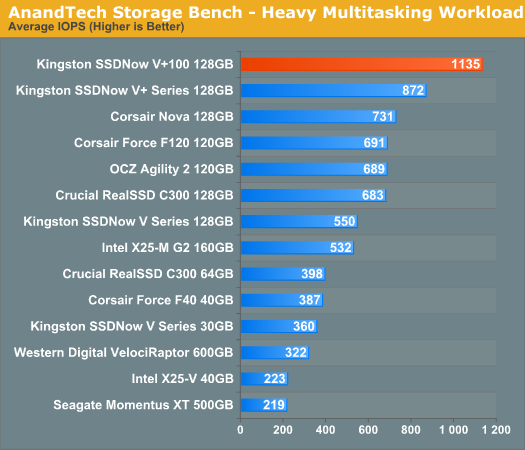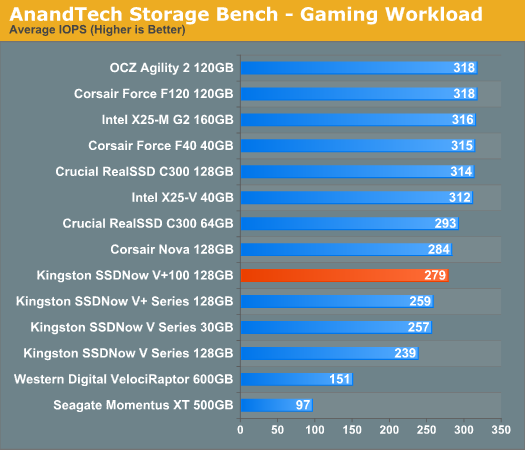Kingston SSDNow V+100 Review
by Anand Lal Shimpi on November 11, 2010 3:05 AM EST- Posted in
- Storage
- SSDs
- Kingston
- SSDNow V+100
AnandTech Storage Bench
To avoid any potential optimizations for industry standard benchmarks and to provide another example of real world performance we've assembled our own storage benchmarks that we've creatively named the AnandTech Storage Bench.
The first in our benchmark suite is a light/typical usage case. The Windows 7 system is loaded with Firefox, Office 2007 and Adobe Reader among other applications. With Firefox we browse web pages like Facebook, AnandTech, Digg and other sites. Outlook is also running and we use it to check emails, create and send a message with a PDF attachment. Adobe Reader is used to view some PDFs. Excel 2007 is used to create a spreadsheet, graphs and save the document. The same goes for Word 2007. We open and step through a presentation in PowerPoint 2007 received as an email attachment before saving it to the desktop. Finally we watch a bit of a Firefly episode in Windows Media Player 11.
There’s some level of multitasking going on here but it’s not unreasonable by any means. Generally the application tasks proceed linearly, with the exception of things like web browsing which may happen in between one of the other tasks.
The recording is played back on all of our drives here today. Remember that we’re isolating disk performance, all we’re doing is playing back every single disk access that happened in that ~5 minute period of usage. The light workload is composed of 37,501 reads and 20,268 writes. Over 30% of the IOs are 4KB, 11% are 16KB, 22% are 32KB and approximately 13% are 64KB in size. Less than 30% of the operations are absolutely sequential in nature. Average queue depth is 6.09 IOs.
The performance results are reported in average I/O Operations per Second (IOPS):

The higher capacity SandForce drives rule the roost here, but the C300, X25-M G2 and V+100 are not too far behind. Despite its age, Intel's X25-M G2 performs very well in our light usage test. The V+100 isn't far behind thanks to its 8.5% improvement over the original V+.
As far as small capacity drives go, the Corsair Force F40 and other similarly sized SandForce drives are the clear winners here. Crucial's 64GB RealSSD C300 is quicker than the X25-V, but no match for the 40GB SF drive.
If there’s a light usage case there’s bound to be a heavy one. In this test we have Microsoft Security Essentials running in the background with real time virus scanning enabled. We also perform a quick scan in the middle of the test. Firefox, Outlook, Excel, Word and Powerpoint are all used the same as they were in the light test. We add Photoshop CS4 to the mix, opening a bunch of 12MP images, editing them, then saving them as highly compressed JPGs for web publishing. Windows 7’s picture viewer is used to view a bunch of pictures on the hard drive. We use 7-zip to create and extract .7z archives. Downloading is also prominently featured in our heavy test; we download large files from the Internet during portions of the benchmark, as well as use uTorrent to grab a couple of torrents. Some of the applications in use are installed during the benchmark, Windows updates are also installed. Towards the end of the test we launch World of Warcraft, play for a few minutes, then delete the folder. This test also takes into account all of the disk accesses that happen while the OS is booting.
The benchmark is 22 minutes long and it consists of 128,895 read operations and 72,411 write operations. Roughly 44% of all IOs were sequential. Approximately 30% of all accesses were 4KB in size, 12% were 16KB in size, 14% were 32KB and 20% were 64KB. Average queue depth was 3.59.

This is another one of those SYSMark-like situations. The old Toshiba controller did just awesome in our heavy multitasking workload and the new update does even better. At 1135 IOPS, the V+100 is 55% faster than the Indilinx based Corsair Nova. Thanks to the incompressible nature of much of the data we're moving around in this benchmark the SandForce drives don't do so well. Although not pictured here, the 256GB C300 would be #2 - still outperformed by the V+100.
The gaming workload is made up of 75,206 read operations and only 4,592 write operations. Only 20% of the accesses are 4KB in size, nearly 40% are 64KB and 20% are 32KB. A whopping 69% of the IOs are sequential, meaning this is predominantly a sequential read benchmark. The average queue depth is 7.76 IOs.

The perplexing nature of the V+100 continues here. While it boasts great sequential read numbers, the smaller and somewhat random accesses drop the V+100 behind the SandForce and Crucial SSDs.










96 Comments
View All Comments
pvdw - Monday, November 15, 2010 - link
"check the speed without compression and then compare drives "That makes no sense!
It's like saying disable branch predictions on one processor because another doesn't have it. Or disable the turbo on one car when comparing to a competing car that is naturally aspirated.
Out of Box Experience - Monday, November 15, 2010 - link
It makes all the sense because it would be a fair comparison of all the SSD's availableNot all drives have compression and not all data is compressible so why not test them all without compression?
Are you afraid that OCZ would be at the bottom of the list in a fair test like this?
Well, you may be right!
Lets test them to be sure
.harm - Thursday, November 11, 2010 - link
I'm not an expert on SSDs and RAID. So excuse me if my question is a bit stupid.I always understood that it´s impossible to use TRIM with a RAID configuration because the RAID controllers can't ´pass' the TRIM commands. So the SSD performance would drop overtime when using RAID. Now the SSD controller has "always-on garbage collection". Does this mean the performance in a RAID configuration doesn't drop?
AnnihilatorX - Thursday, November 11, 2010 - link
I would think so, it would at least be better off than other drive with less aggressive garbage collection.sparky76 - Thursday, November 11, 2010 - link
Will controllers like this leave OS X with a performance advantage over Windows 7, precisely because OS X has no support for the TRIM command?It seems that Win7 will have some system overhead in running TRIM while any OS without TRIM support will not suffer this, as garbage collection will be left to the firmware in the drive.
DoktorSleepless - Thursday, November 11, 2010 - link
I would love to see loading and minimum frame rate tests from actual games like what was done here a while back.http://www.anandtech.com/show/2614/14
It's just really hard to visualize real world performance even from Vantage.
I would bet a game like Fallout 3 would benefit a lot in the minimum frame rate department since it's always loading new data from the hard drive.
Nickel020 - Thursday, November 11, 2010 - link
I second this. While the IOPS for Bench are a nice measure, I don't know how to actually translate that into real world performance differences. I.e. are the differences in IOPS between say the new Kingston drive and Sandforce drives actually noticeable, and if yes, how noticeable?I would like to see a review that shows how much faster a Sandforce drive is than my old Vertex 1 and X25-M G2.
Chloiber - Thursday, November 11, 2010 - link
I'd also like to see that, as I said before.Just look at this test from (german) CB as an example:
http://translate.google.com/translate?js=n&pre...
Huge differences in synthetic tests, but a normal desktop system is just too slow to actually benefit from this!
I'm also missing these kinds of tests here. I think your earlier tests were better - now you just go through synthetic tests and show us the results, this isn't the thing I expected 1 or 2 years ago from an SSD test from anandtech.com. I'd like to see more tests which actually measure performance a user really gets when doing everyday tasks.
pavlindrom - Thursday, November 11, 2010 - link
Wouldn't it be better to have a drive-based sort function run to test how responsive the drive is? I would guess it would stress all of the corners of SSD performance. Write a bunch, shuffle in small portions when flipping values. Maybe it wouldn't test sequential erase. I still think it would show great info.Sufo - Thursday, November 11, 2010 - link
Just a quick recommendation. I have one of these, and i can confirm that with windows 7 (ie TRIM) and a 6gbps bridge the performance is pretty delicious. Grab one, if you meet these requirements.